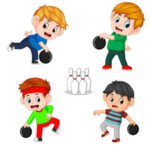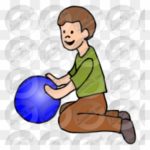
by Neetu | Jun 16, 2020 | Fitness Activity
Ardha-matsyendra-asana (The Half Spinal Twist Pose)
Description: Ardha means half. Matsyendra is one of many Siddhas or masters who were accomplished Yogis mentioned in the medieval Yoga text the Hatha-Yoga-Pradipika. This posture is traditionally called the Spinal Twist because the spinal column is twisted gently.
Teaching Points: “Keeping the abdominal region at ease like the back, bending the left leg, place it on the right thigh; then place on this the elbow of the right hand, and place the face on the palm of the right hand, and fix the gaze between the eye-brows. This is called Matsyendra-posture.”
Performing Instructions
Sit in any comfortable cross-legged position.
- Straighten the legs out in front. Bend the right knee and bring the heel of the right foot close to the left hip.
- Inhale and bend the left knee upward and place the left foot flat on the floor to the right of the right leg with the ankle touching the right thigh.
- While turning the spine to the left straighten the right arm bringing it around to the outside of the left knee and grasp the left foot with the right hand.
- Turn your head as far as possible to the left and bend the left arm behind your back. Keep your spine, neck, and head aligned and continue to exert effort at turning to the left.
- Repeat the posture on the other side by reversing directions 2-6.
Comments:
The Half Spinal Twist is one of the best Yoga postures for cultivating flexibility and strength in the spine. It soothes stiff necks and upper back tension caused by stress, poor posture, or prolonged periods of sitting in one position.
The alternating compression and release of the abdominal region flush this area with blood and massages the internal organs. Muscles of the stomach and hips are also toned from repeated practice of the Half Spinal Twist.
Duration/Repetitions:
The posture can be held for as long as you are comfortable. (One repetition consists of performing the posture on each side. Two to three full repetitions should be done at each session.
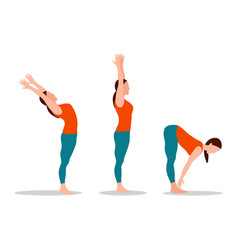
by Neetu | Jun 16, 2020 | Fitness Activity
Posture: Ardhachandra-asana – The Half-moon Pose
(Pronunciation: ard-ha-chun-drah-sa-na)
Description:
The Sanskrit word Ardha means “half,” and the word Chandra means “moon,” thus, this is the “half-moon” posture.
Performing Instructions
- Stand in the tada-asana (Stand with both feet touching from the heel to the big toe, keeping the back straight and the arms pressed slightly against the sides with palms facing inward.
- Bring the hands together at the chest with palms lightly pressed against each other (the Anjali-mudra).
- Inhale and raise the arms straight up keeping the palms pressed lightly together.
- Arch your body backwards keeping your arms alongside your neck and head, tilt the head backward and hold. Keep your knees straight while holding posture.
- Slowly return to the tada-asana.
Comments:
The ardha-chandra-asana is a basic stretching and balancing pose that benefits principly the lower back, abdomen and chest. It isequally suitable for use in your stretching routine as well as formal asana practice.
This pose is also one of the postures that are are sequenced in surya-namaskar (the Sun Salutation).
Duration/Repetitions:
Repeat ardha-chandra-asana two to three times.
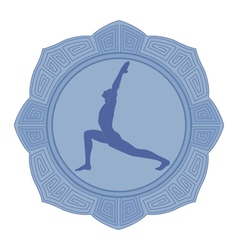
by Neetu | Jun 16, 2020 | Fitness Activity
Posture: Anjanaya-asana – The Salutation Pose
(Pronunciation: Ahn-jah-nay-ah-sa-na)
Description: The Sanskrit word Anjaneya means salutation or praise from the root and which means to honor, to celebrate, to anoint.
Performing Instructions
- Sit comfortably in the vajra-asana (thunderbolt pose).
- Kneel up on your knees until your back, buttocks, and thighs are aligned.
- Extend your left foot forward bending your left knee at about a 90-degree angle.
- Place the palms of your hands together at the heart in the Anjali-mudra.
- Raise your arms straight up keeping the palms together while bending the head backward and looking up.
- Slowly bend backward stretching the arms backward and straightening out the right leg. Hold this position for as long as comfortable while breathing gently through the nostrils.
- Come back to the vajra-asana (thunderbolt pose) then reverse the posture by alternating legs.
Comments:
The Anjaneya-asana combines several postures and mudras (gestures) in a fluid, evolving flow that combines motion, stretching, and holds. It delivers great benefits for the back, arms, chest, legs, and hips. Regular practice will strengthen concentration and improve balance.
Perform this posture with a sense of reverence and praise. Take a moment to reside in silence and peace as your hands are held at the heart in the gesture (mudra) of salutation (Anjali-mudra). Keep the intention of praise in mind as you extend your arms skyward. Feel your entire body-mind-heart extending outward in recognition of the sacredness of life.
Duration/Repetitions:
Repeat twice on each side.
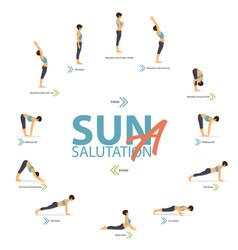
by Neetu | Jun 16, 2020 | Fitness Activity
Posture: Surya-namaskar – Sun Salutation
(Pronunciation: soor-yee-ah-nahma-skar)
Description:
The Sanskrit word Surya means sun. Namaskar is the Hindi word for Namaste, from the root nam, to bow. Namaskar means salutation, salute, greeting, or praise.
STEP ONE:
Stand facing the direction of the sun with both feet touching. Bring the hands together, palm to- palm, at the heart.
STEP TWO:
Stand facing the direction of the sun with both feet touching. Bring the hands together, palm-to-palm, at the heart. Inhale and raise the arms upward. Slowly bend backward, stretching arms above the head.
STEP THREE:
Exhale slowly bending forward, touching the earth with respect until the hands are in line with the feet, head touching knees.
STEP FOUR:
Inhale and move the right leg back away from the body in a wide backward step. Keep the hands and feet firmly on the ground, with the left foot between the hands. Raise the head.
STEP FIVE:
While exhaling, bring the left foot together with the right. Keep arms straight, raise the hips, and align the head with the arms, forming an upward arch.
STEP SIX:
Exhale and lower the body to the floor until the feet, knees, hands, chest, and forehead are touching the ground.
STEP SEVEN:
Inhale and slowly raise the head and bend backward as much as possible, bending the spine to the maximum (as in the naga-asana).
STEP EIGHT:
While exhaling, bring the left foot together with the right. Keep arms straight, raise the hips, and align the head with the arms, forming an upward arch.
STEP NINE:
Inhale and move the right leg back away from the body in a wide backward step. Keep the hands and feet firmly on the ground, with the left foot between the hands. Raise the head.
STEP TEN:
Exhale slowly bending forward, touching the earth with respect until the hands are in line with the feet, head touching knees.
STEP ELEVEN:
Inhale and raise the arms upward. Slowly bend backward, stretching arms above the head.
STEP TWELVE:
Stand facing the direction of the sun with both feet touching. Bring the hands together, palm-to-palm, at the heart.







